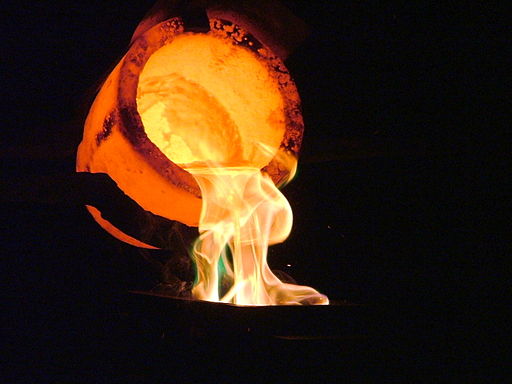Main Content
Lesson 3: Solid Object Modeling
3.2. Solid Objects and Basic Manufacturing Processes
Figure 3.2.1 is an image from Wikimedia Commons of a wooden cogwheel. The wheel was used as a model to manufacture an iron version of the same object. A mold like this might be pressed into wet sand and carefully removed, after which molten iron would be poured into the mold impression in the sand. After this "cast-iron" wheel cooled, it would be removed from the sand and finished through a combination of machining and manual processes.

Many other metals are used in casting. In Figure 3.2.2, gold is poured into a cast to create a bar of bullion.

Subtractive Versus Additive Manufacturing
Mentally consider the wooden and iron cogwheels. The former was created by starting with a piece of wood and removing material; the latter was created by starting with an empty mold and adding material. Therein lies the difference between subtractive manufacturing and additive manufacturing. There are many fundamental processes of subtracting or adding materials in different fields of engineering. But they always begin with a model of some kind, either a physically tangible one like the wheel above or a computer representation.
Subtractive Manufacturing
The white cabinets of the Taylor Guitar Factory (Figure 3.2.3) contain computerized numerical control (CNC) milling machines. From blocks of wood, material is milled off automatically to produce components like guitar necks. The instructions for this precision cutting are generated from a computerized solid-object model of the guitar assembly. A mill operates by holding the stock material in place and moving a cutting head through three-dimensional space.

A CNC lathe (Figure 3.2.4) also uses subtractive processes to shape metal, plastic, or other stock material. It differs from a mill in that its cutting tools are locked into position and the stock moves. Because the stock rotates, a lathe is used when the part being made is symmetrical around an axis. Lathes perform functions like cutting, sanding, drilling, and threading. You might think that, being limited to machining axially symmetrical parts, lathes would be of very limited utility. Not so. It turns out that a surprising percentage of the components used in manufacturing the things we use are axially symmetrical: lamp parts, screws, brake drums, bicycle tubes, plumbing components, and so on.

Note how many of the parts in the device pictured in Figure 3.2.5 are axially symmetrical.

Additive Manufacturing
Now very popular in school technology programs and in makerspaces, 3-D printers like this Airwolf (Figure 3.2.5) can be used to create complex shapes. Inexpensive models typically extrude small beads of plastic in layers, and the three-dimensional movement of the extrusion nozzle is computer controlled. This type of printing is also being done using metals, ceramics, and even food!
With 3-D printing and other additive technologies, it's possible to create remarkably shaped objects. If two materials with different properties are deposited in the same process, it's even possible to add subtractive features to 3-D printed parts. MakerBot Industries sells a water-soluble polymer filament that can be used in conjunction with an insoluble polymer. When the part is put in water, the soluble parts of the component will dissolve away, leaving specified voids.
These modern computerized processes use instructions called G-code, generated by computerized solid models. Note that not all solid models can actually be manufactured from any possible material. For example, you could cut a solid cylinder from quartz using a CNC lathe, but a hollow, intact quartz cylinder isn't possible (unless you happen to find a piece of quartz that has a cylinder-shaped cavity in it!).
Pause to Reflect
Before you proceed, put on your mathematical thinking cap and try to answer a question about how an object could be specified mathematically. Consider this model, a solid plastic cylinder that is 10 centimeters long (about four inches) and one centimeter in diameter.

Figure 3.2.7. Solid Plastic Cylinder, 10 Centimeters in Length and One Centimeter in Diameter
What are some ways that you might mathematically describe the shape of this cylinder to a manufacturing robot (using subtractive and/or additive processes)? Think about this a minute before you proceed to the next page.
